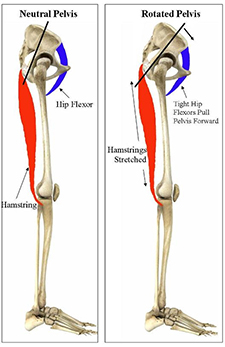Hamstrings Always Tight?
It’s an ailment that runners everywhere seem to battle on a non-stop basis: tight hamstrings. "Why are my hamstrings so tight?” we ask. “I stretch them all the time." Because that’s what we should do with a tight muscle—stretch it. Right?
Not necessarily.
In general, many endurance athletes have an anterior pelvic tilt. What does that mean? It means that their hips fail to maintain a neutral position and, instead, rotate forward. This tilting motion is typically due to tight hip flexors and quadriceps—such as the iliopsoas and rectus femoris—in conjunction with a lack of core strength.
Most of us spend a lot of time sitting throughout the day. Remaining in a seated position for long periods of time causes the iliopsoas and rectus femoris to spend long periods of time in a shortened state, which means they are tightening up. In other words, sitting creates short, tight muscles.
When you think about how much time and effort we put into running, it's easy to see why our core can't keep up. Running is one of the most repetitive, high-load movement patterns with which we can task our bodies. We can work on strengthening our core, but it’s almost impossible to build up enough strength to endure a day in an office chair without feeling the effects in our post-work five-mile run.
So what does all of this have to do with tight hamstrings? Newton's third law of motion states that for every action there is an equal and opposite reaction. If our hips are rotated forward due to shortened hip flexors, then our hamstrings will end up in a lengthened state.  In other words, our hamstrings feel tight not because they are short, but because they are continuously being held in a lengthened position.
In other words, our hamstrings feel tight not because they are short, but because they are continuously being held in a lengthened position.
Stretching and foam rolling a tight hamstring doesn’t reach to the root mechanism that's causing our pain. Trying to lengthen a muscle that's in a chronically lengthened state may actually exacerbate the problem. What we need to do to relieve our hamstrings of their tightness is to lengthen/loosen the quad muscles (rectus femoris) and/or hip flexors (psoas), thus allowing the pelvis to return to a neutral position. If you need help on how to get your pelvis back to neutral, the Fleet Feet Training Center has some excellent workshops and classes designed specifically to attack incorrect movement patterns and tight muscles.
The next time your hamstring starts to give you the finger, work on tackling the mechanism instead of the symptoms. Your hamstrings will thank you for it.
Good Luck and Happy Racing!
Coach Cary
 Tim Cary is FLEET FEET's Assistant Training Manager, coach of the FLEET FEET-sponsored Runnababez Elite team, and manager of the FLEET FEET Racing Team. Over his 20 years of coaching, Tim has coached athletes to three national team championships, five national individual championships, two national records, and numerous All-American and All-State honors. Click here to receive Tim's weekly article via email.
Tim Cary is FLEET FEET's Assistant Training Manager, coach of the FLEET FEET-sponsored Runnababez Elite team, and manager of the FLEET FEET Racing Team. Over his 20 years of coaching, Tim has coached athletes to three national team championships, five national individual championships, two national records, and numerous All-American and All-State honors. Click here to receive Tim's weekly article via email.
Connect With Us
See the latest from Fleet Feet St. Louis